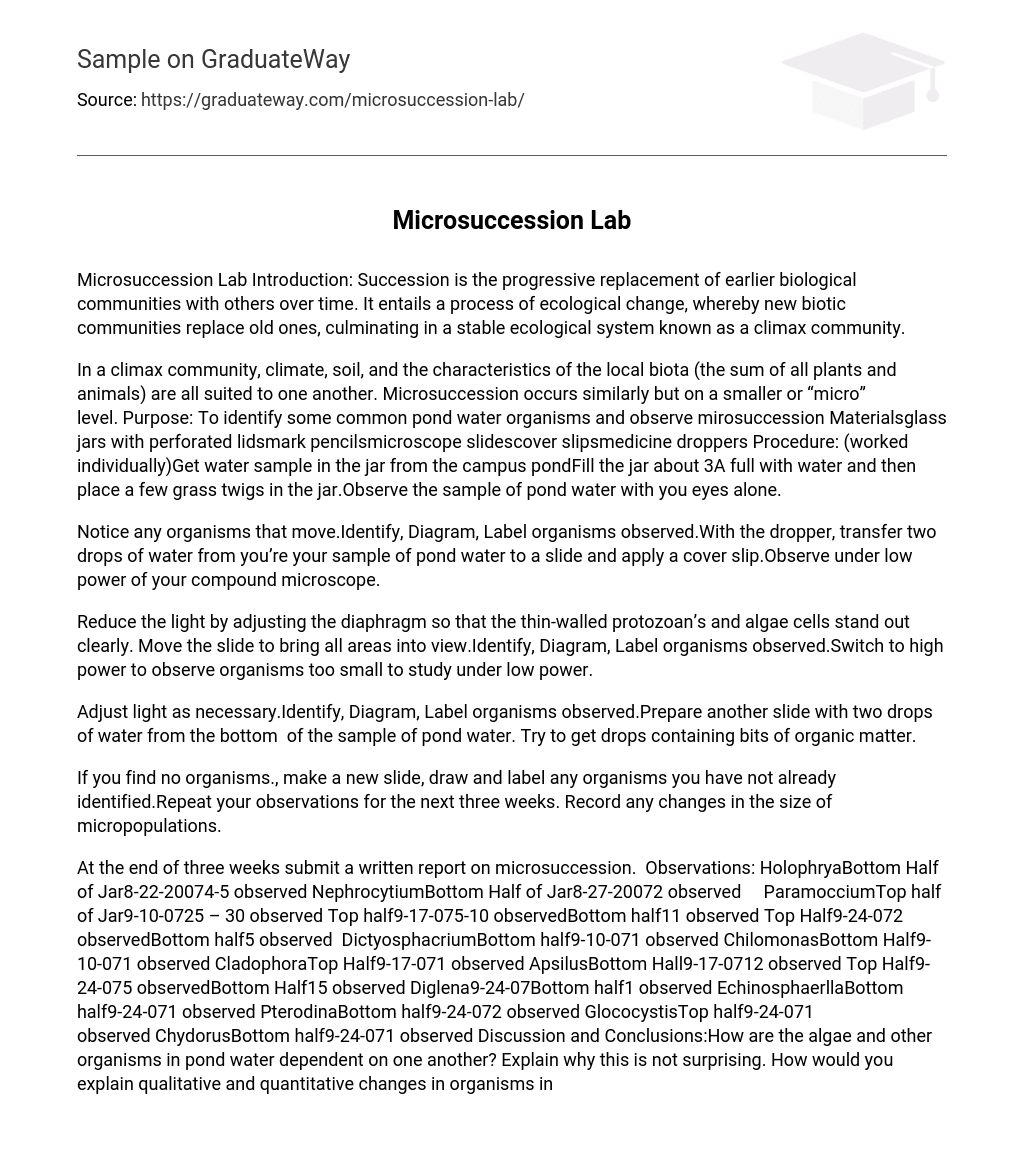Microsuccession Lab Introduction: Succession is the progressive replacement of earlier biological communities with others over time. It entails a process of ecological change, whereby new biotic communities replace old ones, culminating in a stable ecological system known as a climax community.
In a climax community, climate, soil, and the characteristics of the local biota (the sum of all plants and animals) are all suited to one another. Microsuccession occurs similarly but on a smaller or “micro” level. Purpose: To identify some common pond water organisms and observe mirosuccession Materialsglass jars with perforated lidsmark pencilsmicroscope slidescover slipsmedicine droppers Procedure: (worked individually)Get water sample in the jar from the campus pondFill the jar about 3A full with water and then place a few grass twigs in the jar.Observe the sample of pond water with you eyes alone.
Notice any organisms that move.Identify, Diagram, Label organisms observed.With the dropper, transfer two drops of water from you’re your sample of pond water to a slide and apply a cover slip.Observe under low power of your compound microscope.
Reduce the light by adjusting the diaphragm so that the thin-walled protozoan’s and algae cells stand out clearly. Move the slide to bring all areas into view.Identify, Diagram, Label organisms observed.Switch to high power to observe organisms too small to study under low power.
Adjust light as necessary.Identify, Diagram, Label organisms observed.Prepare another slide with two drops of water from the bottom of the sample of pond water. Try to get drops containing bits of organic matter.
If you find no organisms., make a new slide, draw and label any organisms you have not already identified.Repeat your observations for the next three weeks. Record any changes in the size of micropopulations.
At the end of three weeks submit a written report on microsuccession. Observations: HolophryaBottom Half of Jar8-22-20074-5 observed NephrocytiumBottom Half of Jar8-27-20072 observed ParamocciumTop half of Jar9-10-0725 – 30 observed Top half9-17-075-10 observedBottom half11 observed Top Half9-24-072 observedBottom half5 observed DictyosphacriumBottom half9-10-071 observed ChilomonasBottom Half9-10-071 observed CladophoraTop Half9-17-071 observed ApsilusBottom Hall9-17-0712 observed Top Half9-24-075 observedBottom Half15 observed Diglena9-24-07Bottom half1 observed EchinosphaerllaBottom half9-24-071 observed PterodinaBottom half9-24-072 observed GlococystisTop half9-24-071 observed ChydorusBottom half9-24-071 observed Discussion and Conclusions:How are the algae and other organisms in pond water dependent on one another? Explain why this is not surprising. How would you explain qualitative and quantitative changes in organisms in the jar at the end of 4 weeks Organisms within an environment, even a micro-environment are dependent on each for food, protection, essential nutrients. Each type of organism in pond water has a specific purpose, and acts a producer.
Similarly, each type of organism has specific energy requirements, and acts as a consumer. For example algae grows and is used to feed the organisms which were observed in this lab. In addition, this organism do not just feed on algae but act to control the growth of algae and ensure that it does not grow uncontrollably. In return the amount of available algae maintains the growth and reproduction of organisms.
Algae also helps to produce or “cycle” essential nutrients into the environment like nitrogen, and oxygen. Organisms which appear at the top of the jar need immediate access to oxygen and sunlight. Organisms which are found in the bottom half of the jar needs less sunlight to survive. Organisms will migrate to the place in the environment which is most suitable to them.
This is why you seen a change in the number of Apsilus and Paramoccium. Once the food is depleted in their area they move to an area with more food. Once the food is gone completely they will die and numbers decrease. Organisms at the bottom half of the jar will continue to decrease because their food and energy supply will decrease and eventually deplete completely.
At four weeks and after there will be steady decline because the nutrients which come from the natural environment will not be present. In addition, the natural cleaning of the environment will not occur.





